Raider Culture
Raiders are the evil men who live in the domains under Sauron's shadow, to the south and east of Gondor and Rohan. In this game,
Raider culture is an Shadow cultures of evil man minions, and is itself split into three subcultures: the ambushing, oliphaunt-riding archers of the Southron Haradrim, the disciplined, ferocious warriors of the Easterlings, and the larcenous piratical Corsairs of Umbar. Stereotypical dark-skinned, vaguely Persian or Turkic invaders who subscribe to an evil foreign religion may not have aged terribly well, but, hey, playing them means sometimes you get to step on Legolas with a giant war elephant or send an unkempt Peter Jackson to single-handedly crush the entire Fellowship, so you take the good with the bad.
Raider culture as a whole was first introduced in The Two Towers, alongside another, separate faction of evil men,
Dunland. Initially,
Raiders only included the first two subcultures, Southrons and Easterlings. Both subfactions received more cards and developed over the course of Tower Block, but really came into their own with The Return of the King. Then Siege of Gondor introduced Corsairs and their boats, introducing what would remain a top-tier strategy in Movie Block to this day.
All three Raider subcultures were retired after King Block. The 11th set, Shadows, reorganized and consolidated the Shadow cultures. All of
Raider culture was combined with the other evil men to make
Men culture.
[edit]
The entire culture is one culture, but the way it's split into three means that most decks pick a subculture and stick with it, only using cards from other subcultures to supplement their strategy. In this way, Raider culture resembles
Isengard, although the subcultural enforcement isn't nearly so strong. Part of the looseness of this subcultural enforcement is that some cards are weakly aligned with one subfaction or another. A card like Discovered (4R223)
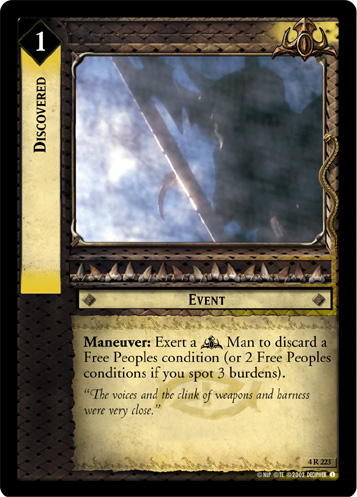 meshes well with the Easterling plan of placing and spotting burdens, but it's a useful tool for all three subcultures.
meshes well with the Easterling plan of placing and spotting burdens, but it's a useful tool for all three subcultures.
Raiders have powerful but generally expensive event cards. The most (in)famous are their flashy, risky cards to unexpectedly remove troublesome companions: Whirling Strike (4C260)
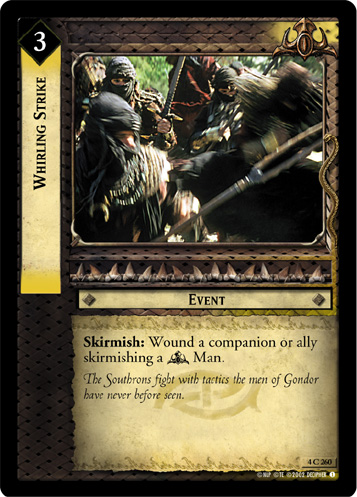 , Red Wrath (7U157)
, Red Wrath (7U157)
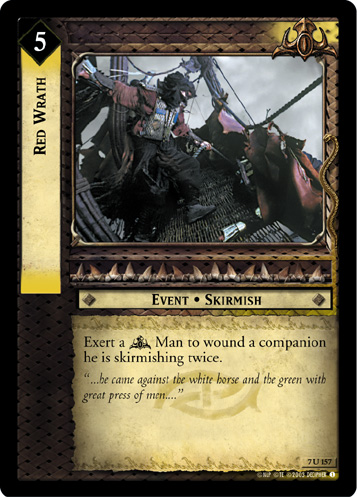 , and Fierce in Despair (7R148)
, and Fierce in Despair (7R148)
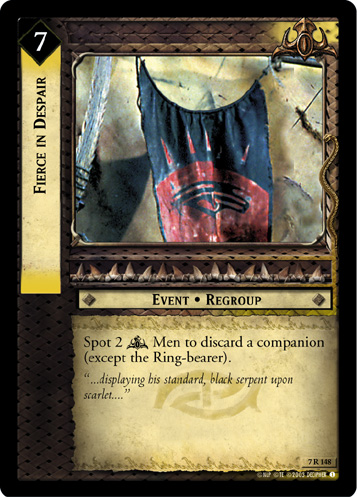 . In theory, these three cards are meant to enable a strategy where you use the Southron signature keyword Ambush to pay for these powerful events. In practice, they're mostly used to soak up extra twilight from an opponent who has flooded, which is common in Movie Block. This predilection for expensive events also extends to many of their more mundane effects: non-Corsair subcultures have relatively overpriced pump events, On the March (4C241)
. In theory, these three cards are meant to enable a strategy where you use the Southron signature keyword Ambush to pay for these powerful events. In practice, they're mostly used to soak up extra twilight from an opponent who has flooded, which is common in Movie Block. This predilection for expensive events also extends to many of their more mundane effects: non-Corsair subcultures have relatively overpriced pump events, On the March (4C241)
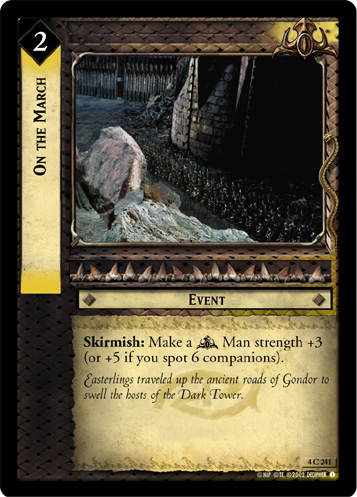 and New Strength Came Now (7C154)
and New Strength Came Now (7C154)
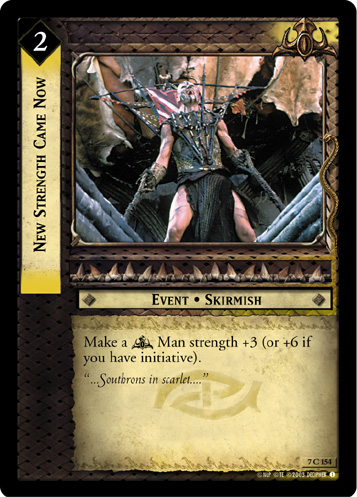 . These are rarely played; instead, players tend to use the many
. These are rarely played; instead, players tend to use the many Raider utility conditions like Under Foot (10C52)
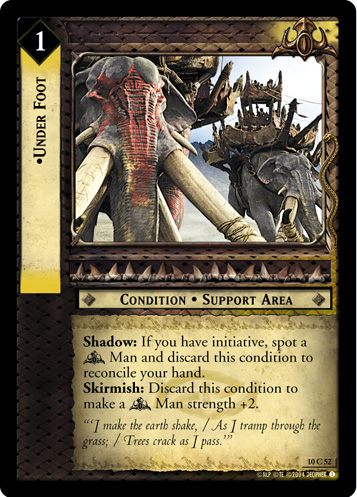 , Small Hope (7R159)
, Small Hope (7R159)
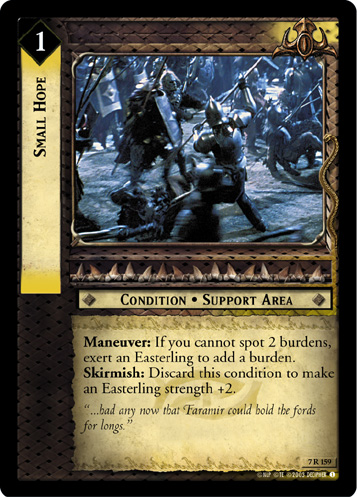 , and Field of the Fallen (10U43)
, and Field of the Fallen (10U43)
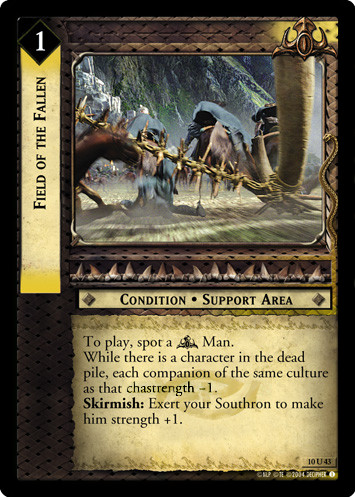 that have pump effects attached to their main effect.
that have pump effects attached to their main effect.
Speaking of which, Raiders have powerful support area cards to enable cycling. Under Foot (10C52)
 is a keystone of swarming strategies (often multicultural or rainbow strategies like Moria Navy or Stupid Swarm). Ships of Great Draught (8R65)
is a keystone of swarming strategies (often multicultural or rainbow strategies like Moria Navy or Stupid Swarm). Ships of Great Draught (8R65)
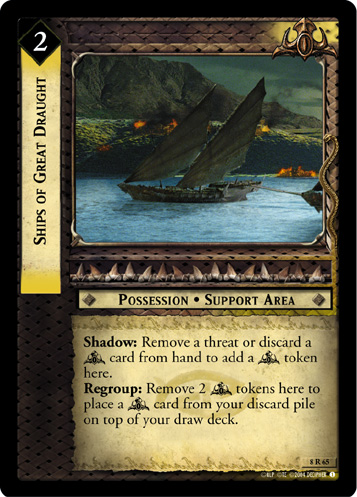 not only allows you to never have to worry about a hand clogged with Shadow cards, but also lets you retrieve a situational card or play a particularly troublesome card over and over again. With the addition of Corsair War Galley (8U59)
not only allows you to never have to worry about a hand clogged with Shadow cards, but also lets you retrieve a situational card or play a particularly troublesome card over and over again. With the addition of Corsair War Galley (8U59)
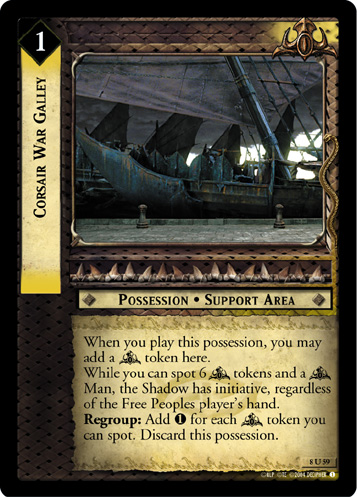 , this can also give you a near-continuous hold on Initiative, needed to enable certain Southron and Corsair strategies.
, this can also give you a near-continuous hold on Initiative, needed to enable certain Southron and Corsair strategies.
In theory, Raiders also have strong shared possessions that you play on minions, like Raider Bow (7C155)
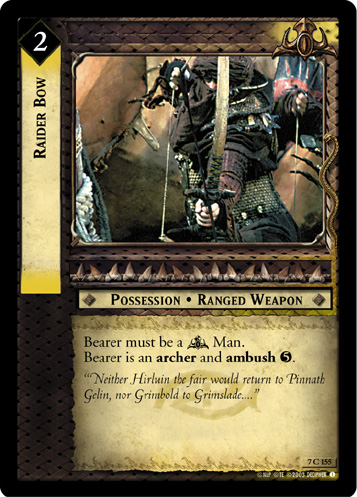 and Raider Halberd (7C156)
and Raider Halberd (7C156)
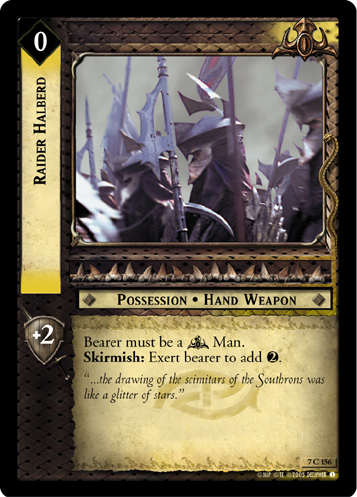 . In practice, both of these cards are only common in one single subculture, and neither one is popular in the culture it's styled after! Both of them appear below along with the corresponding decks.
. In practice, both of these cards are only common in one single subculture, and neither one is popular in the culture it's styled after! Both of them appear below along with the corresponding decks.
Most Raider minions are too tightly integrated into their subculture to really work in any deck that isn't devoting significant space to
Raider cards. There's one exception: Desert Lord (4R219)
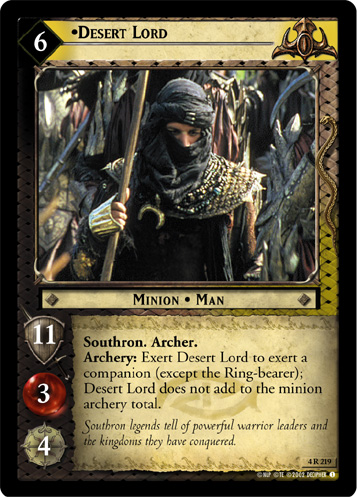 . He's great for exhausting annoying characters that need to exert to use their abilities, like Legolas, Greenleaf (1R50)
. He's great for exhausting annoying characters that need to exert to use their abilities, like Legolas, Greenleaf (1R50)
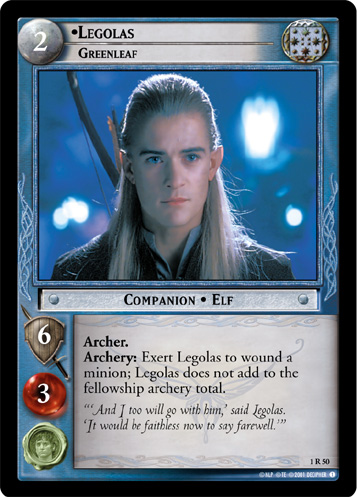 , Círdan, The Shipwright (10R8)
, Círdan, The Shipwright (10R8)
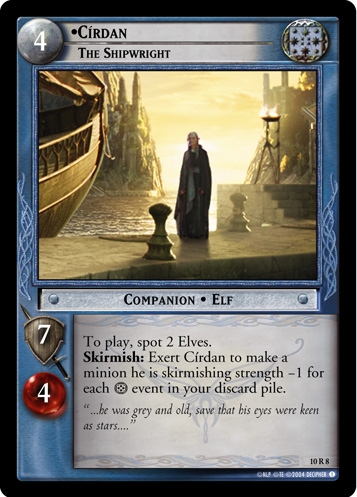 , and Éowyn, Lady of Ithilien (10R72)
, and Éowyn, Lady of Ithilien (10R72)
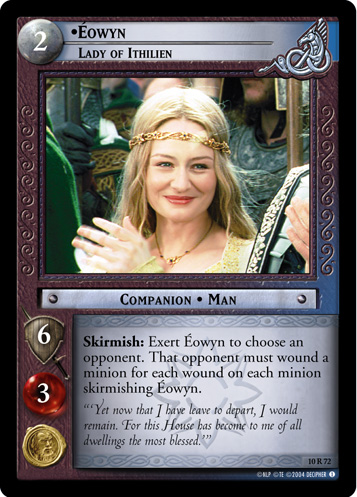 . You can just slam him down, get two direct wounds out of him, and maybe even get a third one when he goes to skirmish. He's just a really great value card that fits into a variety of decks.
. You can just slam him down, get two direct wounds out of him, and maybe even get a third one when he goes to skirmish. He's just a really great value card that fits into a variety of decks.
Southrons[edit]
See also: Southron
Southrons have turbans and bows and they're sneaky ambushing desert warriors but also they have oliphaunts. I guess they're sneaky giant war elephants. Southrons are the least focused of the three Raider subfactions, dabbling in a variety of areas and strategies. Even their subcultural enforcement is sometimes tricky: if a card mentions "a
archer" or "a mounted
Man" then it's a card for Southrons, since they have (almost) all of the
Raider archers and all of the
Raider mounts. Southrons are all over the place, but in practice they have about three-ish common decks, depending on how you count.
Those decks have a shared toolbox. Southrons love to have a bunch of threats sloshing around, and Rallying Call (10U47)
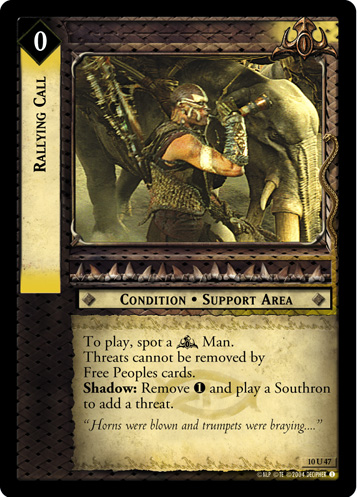 or War Towers (7C173)
or War Towers (7C173)
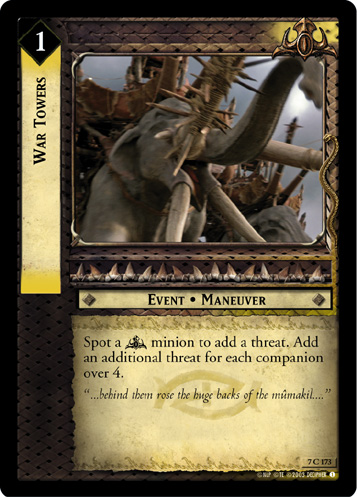 can generate those threats cheaply. These threats can be turned into wounds by killing a companion, or used to fund cards like Southron Marksmen (7R167)
can generate those threats cheaply. These threats can be turned into wounds by killing a companion, or used to fund cards like Southron Marksmen (7R167)
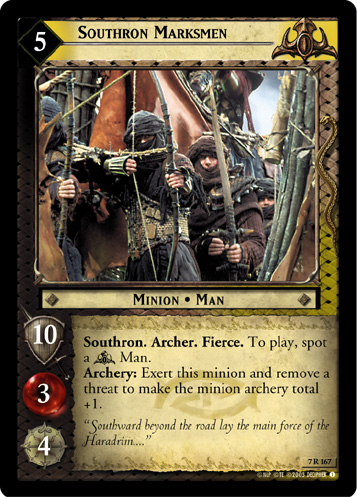 or Ships of Great Draught (8R65)
or Ships of Great Draught (8R65)
 . High Vantage (10U44)
. High Vantage (10U44)
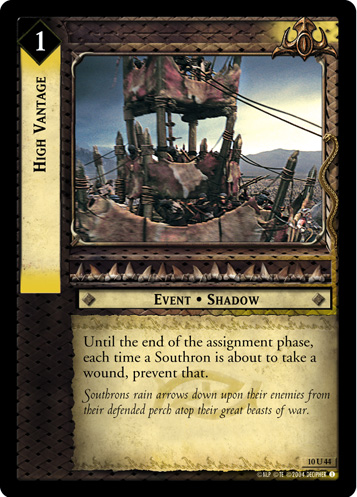 can efficiently stymie many wounding strategies. They also have some above-average hate cards for overly large or rainbow Fellowships, such as Southron Leader (7R166)
can efficiently stymie many wounding strategies. They also have some above-average hate cards for overly large or rainbow Fellowships, such as Southron Leader (7R166)
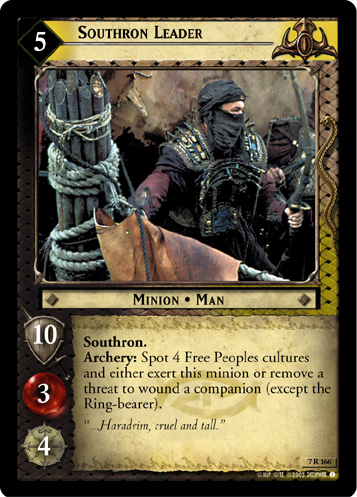 , Southron Commander (4U249)
, Southron Commander (4U249)
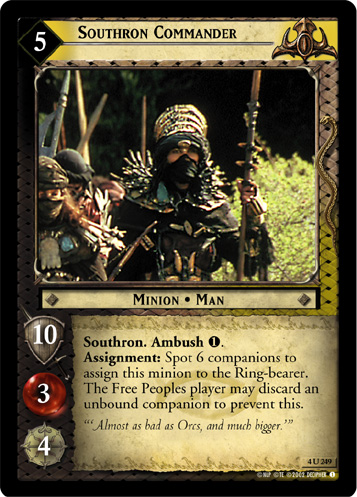 , and Southron Veterans (4R257)
, and Southron Veterans (4R257)
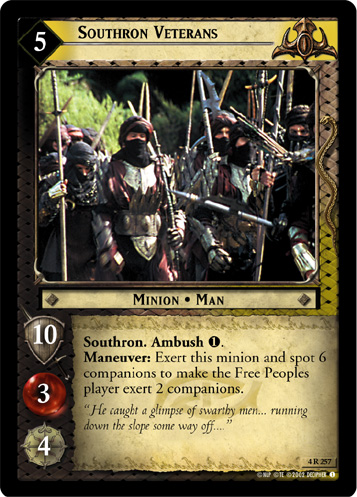 . All of these cards are fairly situational, but that's fine! As long as you have Ships of Great Draught (8R65)
. All of these cards are fairly situational, but that's fine! As long as you have Ships of Great Draught (8R65)
 , you can pitch them into discard easily, or retrieve them later at your convenience.
, you can pitch them into discard easily, or retrieve them later at your convenience.
The least important part of Southrons is their signature keyword: Ambush. Ambush generates twilight when minions are assigned. In theory, you'd use it to fund the expensive Raider events, or conditions like Howl of Harad (4U236)
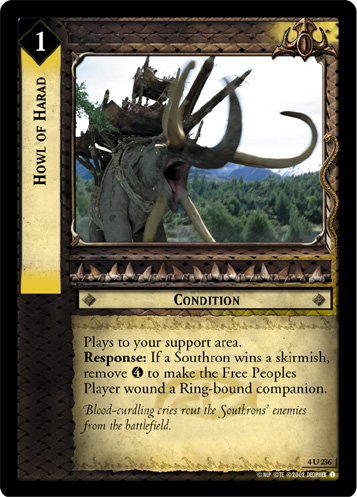 or Harsh Tongues (7C150)
or Harsh Tongues (7C150)
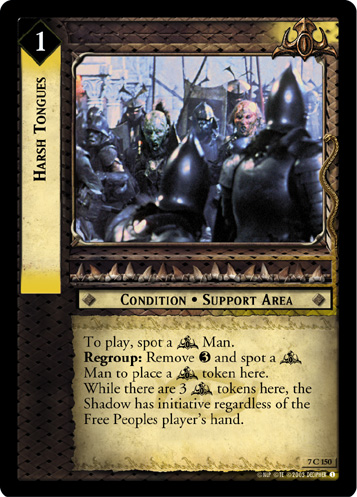 . In practice, the Ambush numbers are too small to pay for very much, and the minions with Ambush are largely too weak to be worth bothering with. Insofar as Ambush is used in Southron decks at all, it's largely a little extra on a card that's good enough to use anyway.
. In practice, the Ambush numbers are too small to pay for very much, and the minions with Ambush are largely too weak to be worth bothering with. Insofar as Ambush is used in Southron decks at all, it's largely a little extra on a card that's good enough to use anyway.
Southrons also dabble in site control, but their cards for actually controlling sites are so inefficient that they're rarely worth bothering with. The only card of note is Southron Archer (4R245)
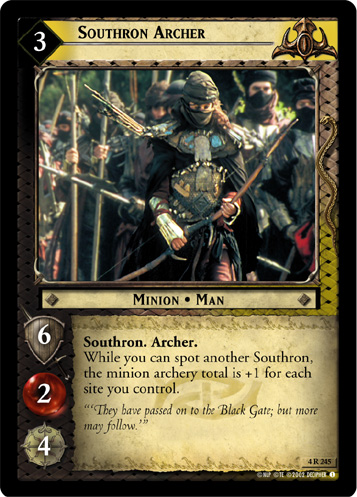 . Southron Archer can be splashed into other cultures' site control decks, or Movie Block decks focusing on Southron archers can use Crashed Gate (8U119)
. Southron Archer can be splashed into other cultures' site control decks, or Movie Block decks focusing on Southron archers can use Crashed Gate (8U119)
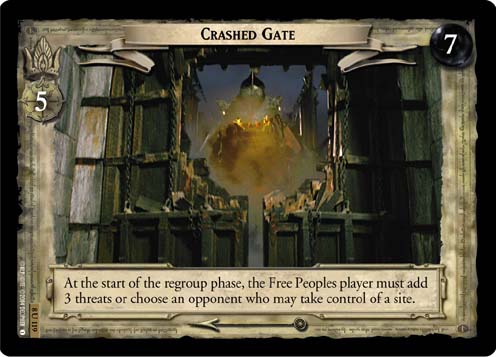 as a win-win option.
as a win-win option.
Southron direct wounding[edit]
The Southron direct wounding deck is two decks, both using very similar strategies. Cards like Desert Warrior (4C222)
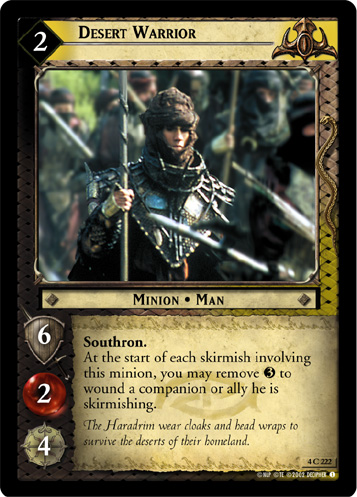 and Desert Sneak (7C135)
and Desert Sneak (7C135)
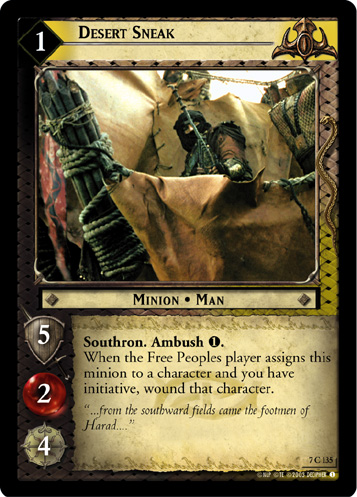 trigger at the beginning of a skirmish, either consuming twilight or looking for initiative to cause a wound. These two styles of cards form the basis for two different decks.
trigger at the beginning of a skirmish, either consuming twilight or looking for initiative to cause a wound. These two styles of cards form the basis for two different decks.
The first deck was mainly known as the "Ambush" or "Howl of Harad" deck. Using mainly Tower Block cards, it turns a twilight flood into direct wounds. Desert Warrior (4C222)
 , Desert Spearman (4C221)
, Desert Spearman (4C221)
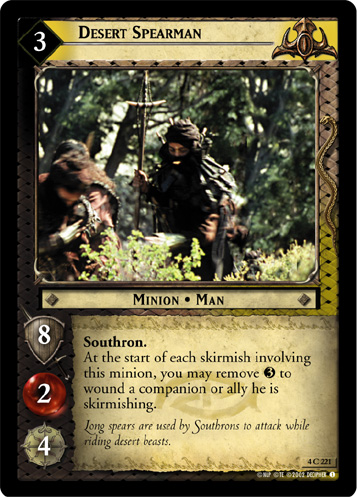 , and Desert Soldier (4U220)
, and Desert Soldier (4U220)
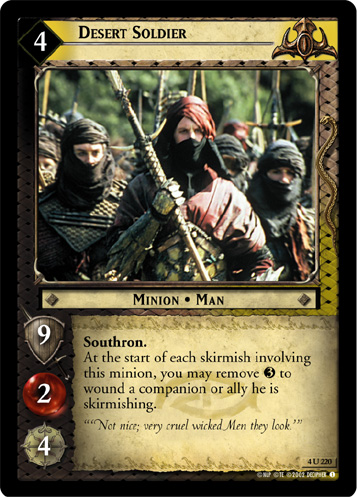 turn the twilight from cheap Ambush minions like Southron Runner (5C75)
turn the twilight from cheap Ambush minions like Southron Runner (5C75)
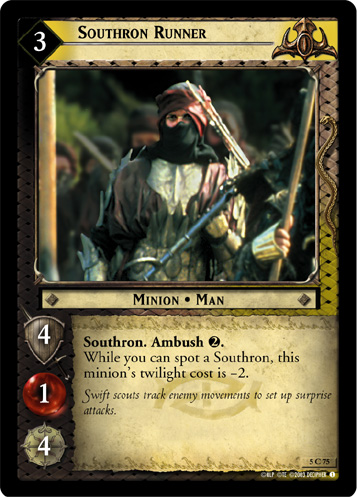 or Southron Scout (4C252)
or Southron Scout (4C252)
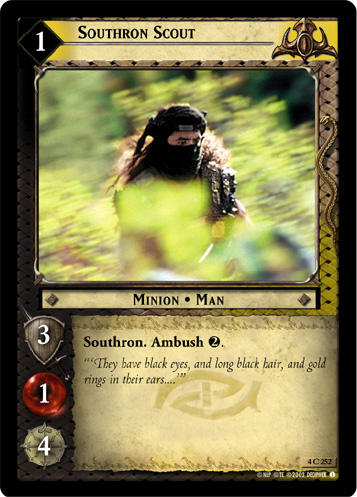 into direct wounds. Southron Assassin (4R246)
into direct wounds. Southron Assassin (4R246)
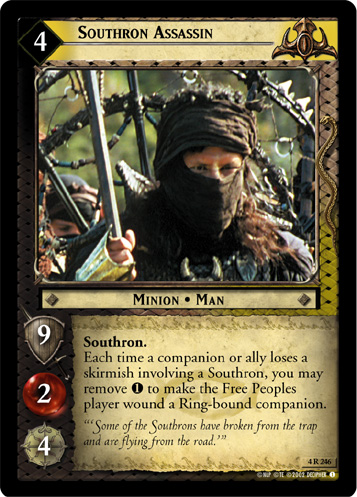 , Howl of Harad (4U236)
, Howl of Harad (4U236)
 , and Whirling Strike (4C260)
, and Whirling Strike (4C260)
 . While this is the basis of the Legolas starter deck in Battle of Helm's Deep, it was never a strong or competitive deck. King Block adds some cards clearly aimed at this strategy, like Raider Bow (7C155)
. While this is the basis of the Legolas starter deck in Battle of Helm's Deep, it was never a strong or competitive deck. King Block adds some cards clearly aimed at this strategy, like Raider Bow (7C155)
 , Red Wrath (7U157)
, Red Wrath (7U157)
 , and Cast Unto the Winds (10C36)
, and Cast Unto the Winds (10C36)
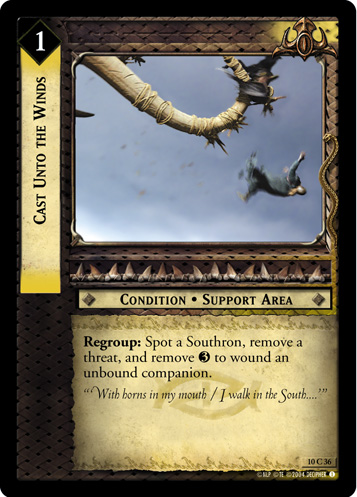 , but it never quite comes together.
, but it never quite comes together.
Instead, the successful version of this deck is Southron Initiative, using mainly King Block cards. Desert Sneak (7C135)
 , Desert Runner (7C133)
, Desert Runner (7C133)
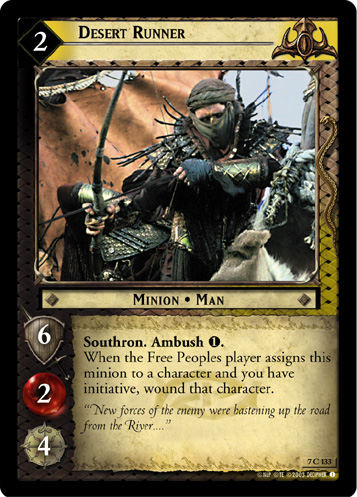 , and sometimes Desert Scout (7U134)
, and sometimes Desert Scout (7U134)
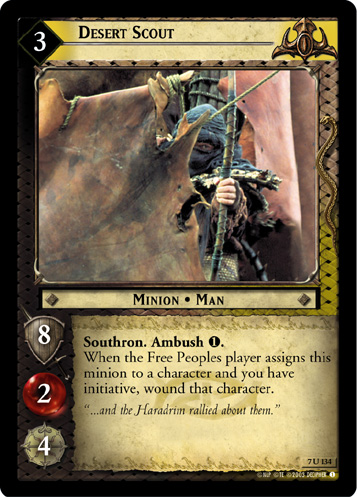 all wound companions for free when you have initiative, plus they themselves have Ambush to fund the expensive support cards above like Howl of Harad (4U236)
all wound companions for free when you have initiative, plus they themselves have Ambush to fund the expensive support cards above like Howl of Harad (4U236)
 or Whirling Strike (4C260)
or Whirling Strike (4C260)
 . Southron Invaders (6C81)
. Southron Invaders (6C81)
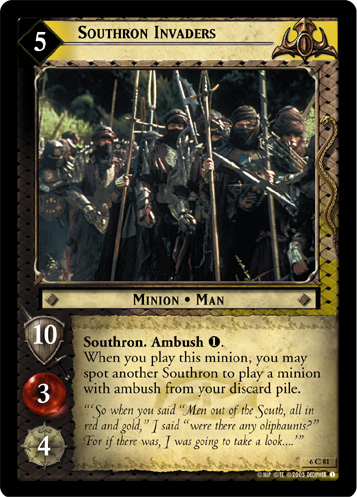 recycles these super-cheap minions. To get initiative, you can either use Corsair War Galley (8U59)
recycles these super-cheap minions. To get initiative, you can either use Corsair War Galley (8U59)
 . (Harsh Tongues (7C150)
. (Harsh Tongues (7C150)
 is too expensive and Southron Chieftain (7R163)
is too expensive and Southron Chieftain (7R163)
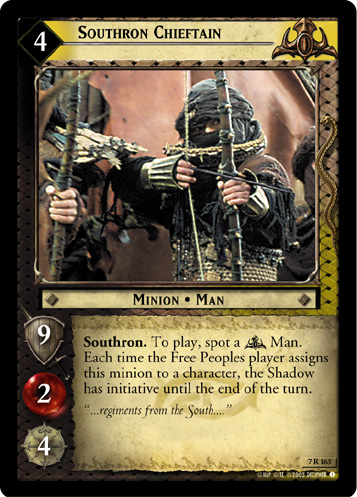 is too unreliable.) If you're using the Galley, you can just trigger it with Ships of Great Draught (8R65)
is too unreliable.) If you're using the Galley, you can just trigger it with Ships of Great Draught (8R65)
 , or run the deck as a hybrid with Corsairs. Since you have initiative, cheap splashable cards that exploit initiative like Gollum, Plotting Deceiver (7R58)
, or run the deck as a hybrid with Corsairs. Since you have initiative, cheap splashable cards that exploit initiative like Gollum, Plotting Deceiver (7R58)
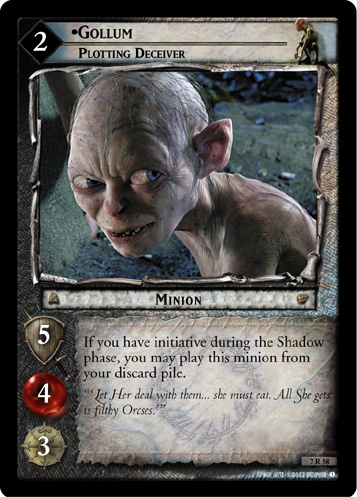 or Morgul Lurker (8C76)
or Morgul Lurker (8C76)
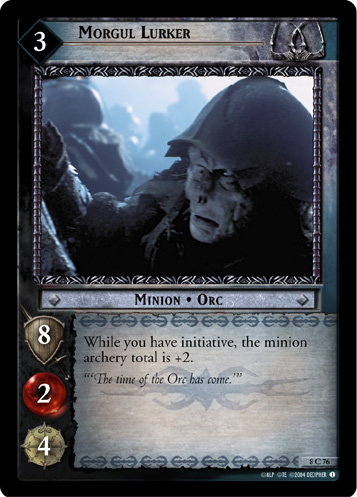 can be useful.
can be useful.
Example deck: Echo of Luthien/Initiative Southrons, a Movie Block deck by sgtdraino on The Last Homely House forums. This version of the deck is a hybrid with Corsairs, and also runs a bunch of other splashable minions.
Southron Archery[edit]
See also: Southron Archery
Southron archers aren't quite as dirt-cheap as Moria's: the cheapest ones are Southron Bowman (4C248)
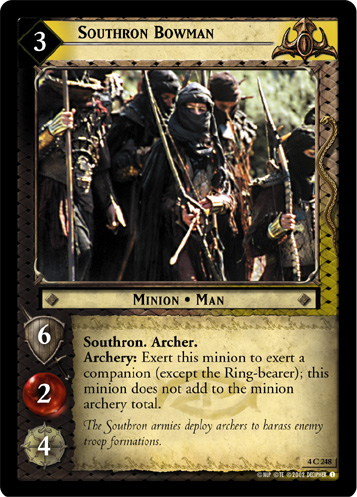 and Southron Archer (4R245)
and Southron Archer (4R245)
 , followed by Elite Archer (4U232)
, followed by Elite Archer (4U232)
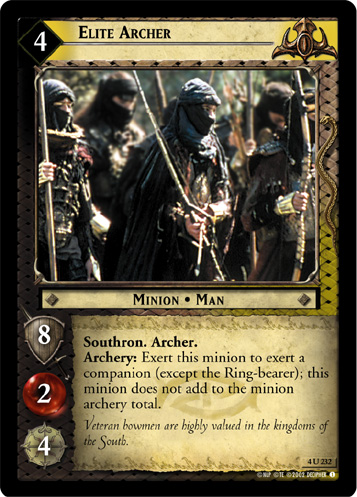 . But, similar to Uruk Archery, they also have archer minions with enough strength to skirmish decently well, with Desert Lord (4R219)
. But, similar to Uruk Archery, they also have archer minions with enough strength to skirmish decently well, with Desert Lord (4R219)
 , Haradrim Marksman (8U60)
, Haradrim Marksman (8U60)
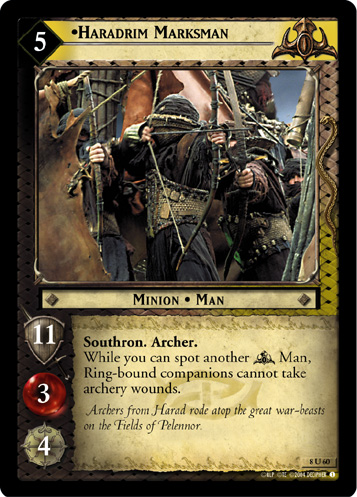 , and Southron Marksmen (7R167)
, and Southron Marksmen (7R167)
 . (There are some more-expensive archers that can exploit a heavily flooded twilight pool, but they are overpriced and not popular.) Southron Bow (4R247)
. (There are some more-expensive archers that can exploit a heavily flooded twilight pool, but they are overpriced and not popular.) Southron Bow (4R247)
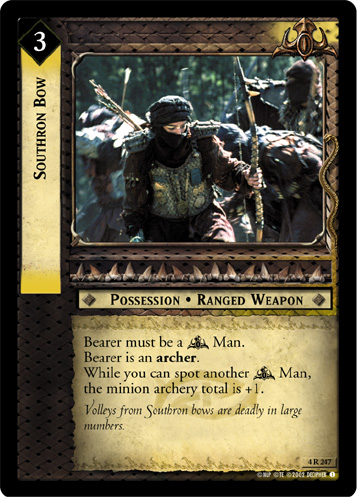 is fairly expensive, but it's worth at least one extra archery wound, and two if you play it on a non-archer. The deck usually runs Rallying Call (10U47)
is fairly expensive, but it's worth at least one extra archery wound, and two if you play it on a non-archer. The deck usually runs Rallying Call (10U47)
 and/or War Towers (7C173)
and/or War Towers (7C173)
 , both to fund Southron Marksmen and Ships of Great Draught (8R65)
, both to fund Southron Marksmen and Ships of Great Draught (8R65)
 but also to push even more wounds every time a companion dies. Seasoned Leader (10R48)
but also to push even more wounds every time a companion dies. Seasoned Leader (10R48)
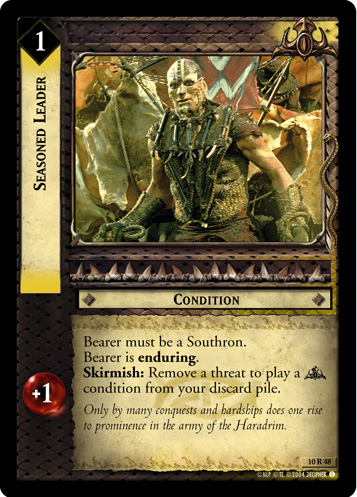 lets minions like Desert Lord (4R219)
lets minions like Desert Lord (4R219)
 get an extra use of their abilities, and that lends itself naturally to hybridizing this deck with the Southron Mumaks deck below. Alternately, you can just combine this with cheap efficient archers from other cultures, like Goblin Bowman (2C60)
get an extra use of their abilities, and that lends itself naturally to hybridizing this deck with the Southron Mumaks deck below. Alternately, you can just combine this with cheap efficient archers from other cultures, like Goblin Bowman (2C60)
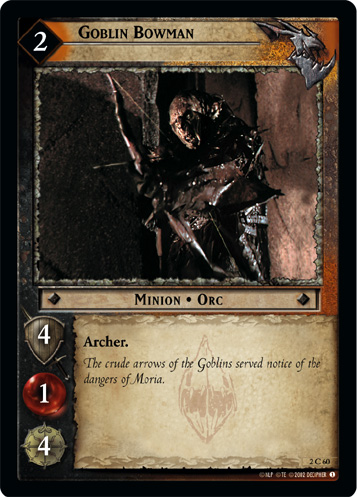 and Morgul Ambusher (8C74)
and Morgul Ambusher (8C74)
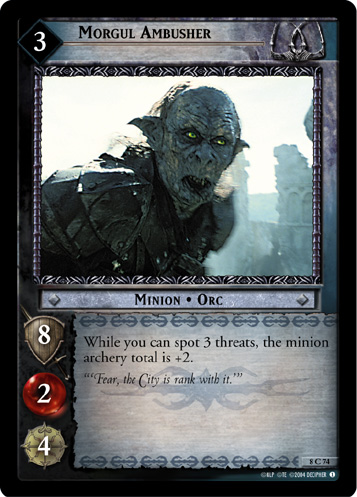 , or use the low-cost Southron archers in an archery deck focused on another culture, or just a rainbow archery deck.
, or use the low-cost Southron archers in an archery deck focused on another culture, or just a rainbow archery deck.
Example deck: Southron archers with boats, a Movie Block deck by Cease on The Last Homely House forums. This is an example of a hybrid using Mûmak Chieftain (10R45)
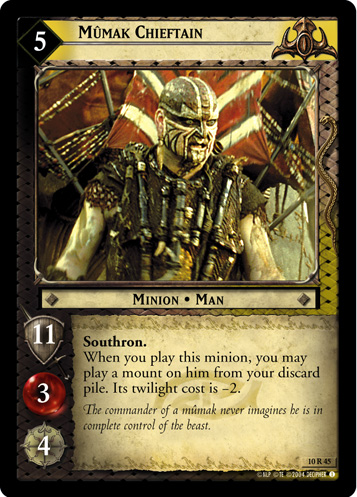 .
.
Southron Mumaks[edit]
Mûmak Chieftain (10R45)
 is just a really strong card. As long as you have a Mûmak (5C73)
is just a really strong card. As long as you have a Mûmak (5C73)
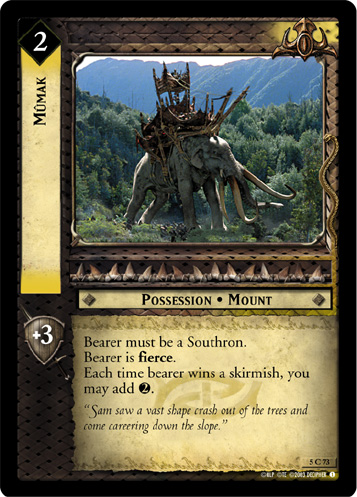 in the discard pile to retrieve, the Chieftain is a 14 strength, 3 vitality minion with Fierce that also generates some twilight. Seasoned Leader (10R48)
in the discard pile to retrieve, the Chieftain is a 14 strength, 3 vitality minion with Fierce that also generates some twilight. Seasoned Leader (10R48)
 combined with Field of the Fallen (10U43)
combined with Field of the Fallen (10U43)
 can push that strength up, too. There's even a very dirty combo where you use Seasoned Leader to recycle Ithilien Wilderness (4R237)
can push that strength up, too. There's even a very dirty combo where you use Seasoned Leader to recycle Ithilien Wilderness (4R237)
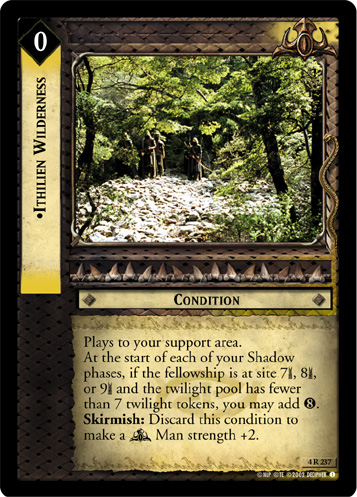 (or a slightly more-expensive, more-useful card like Under Foot (10C52)
(or a slightly more-expensive, more-useful card like Under Foot (10C52)
 ) in your discard pile over and over, each time turning 1 threat into +2 strength to set up an overwhelm. Once you're sure you'll get it, spend a threat to play Bold Men and Grim (7R129)
) in your discard pile over and over, each time turning 1 threat into +2 strength to set up an overwhelm. Once you're sure you'll get it, spend a threat to play Bold Men and Grim (7R129)
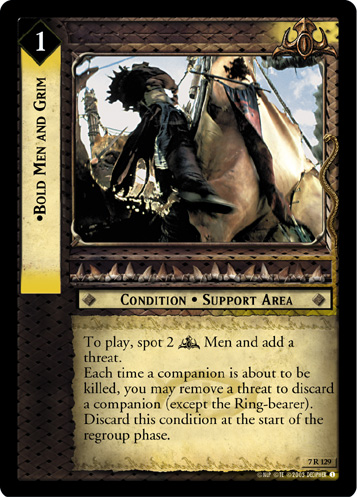 , which immediately replaces the threat and lets you discard an extra companion. Ships of Great Draught (8R65)
, which immediately replaces the threat and lets you discard an extra companion. Ships of Great Draught (8R65)
 will help pitch these cards into the discard pile for you to set up the combos.
will help pitch these cards into the discard pile for you to set up the combos.
The issue with this deck is what you do until you get those cards into discard. Desert Lord (4R219)
 and Southron Marksmen (7R167)
and Southron Marksmen (7R167)
 tend to exert themselves, making them very good Seasoned Leader (10R48)
tend to exert themselves, making them very good Seasoned Leader (10R48)
 users, but there really isn't an efficient Southron skirmisher for about 4-6 twilight besides the Chieftain. As a result, Southron Mumaks are largely a secondary strategy, added onto one of the other two main Southron strategies.
users, but there really isn't an efficient Southron skirmisher for about 4-6 twilight besides the Chieftain. As a result, Southron Mumaks are largely a secondary strategy, added onto one of the other two main Southron strategies.
Easterlings[edit]
See also: Easterling
Easterlings are disciplined, ferocious warriors of the, uh, East. Unlike the Southrons, they have a very straightforward game plan: they want to put at least two burdens on the ring-bearer, then beat the Fellowship down with efficient Fierce minions. The subculture had the efficient minions from day one, but it didn't really come into its own until Return of the King added some key cards to easily place the necessary burdens, as well as some possessions to round things out.
The main Easterling deck is a King Standard/Movie Block deck: Beasterlings. The deck uses Small Hope (7R159)
 (and sometimes Easterling Footman (7R143)
(and sometimes Easterling Footman (7R143)
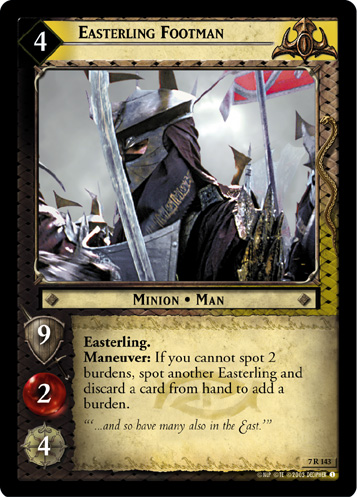 ) to place two burdens quickly and efficiently. Once that's done, the ideal setup is Easterling Captain (4R225)
) to place two burdens quickly and efficiently. Once that's done, the ideal setup is Easterling Captain (4R225)
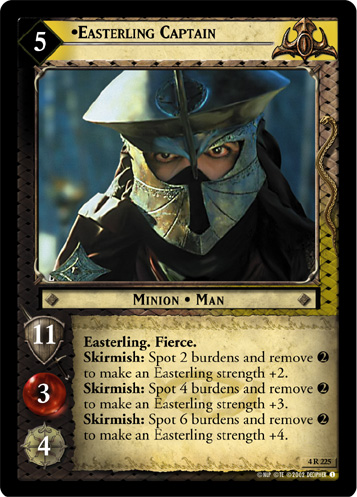 bearing Raider Bow (7C155)
bearing Raider Bow (7C155)
 to generate twilight for his ability and Easterling Polearm (6U79)
to generate twilight for his ability and Easterling Polearm (6U79)
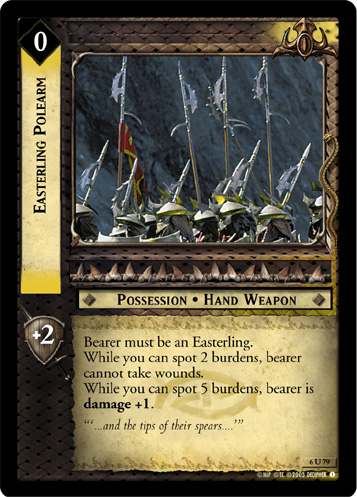 to protect him from being killed. This can overwhelm many companions, or generate enough twilight to use Red Wrath (7U157)
to protect him from being killed. This can overwhelm many companions, or generate enough twilight to use Red Wrath (7U157)
 to deal with the ones you can't. Easterling Army (6R78)
to deal with the ones you can't. Easterling Army (6R78)
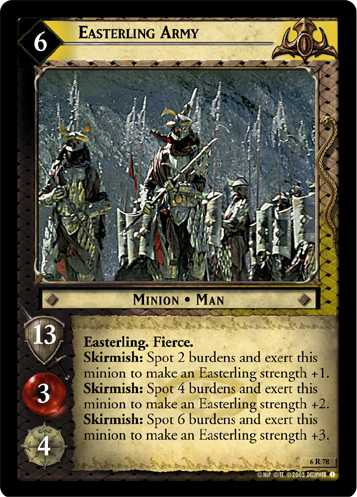 is somewhat less efficient but can serve the same role or pump the Captain. Easterling Axeman (4C224)
is somewhat less efficient but can serve the same role or pump the Captain. Easterling Axeman (4C224)
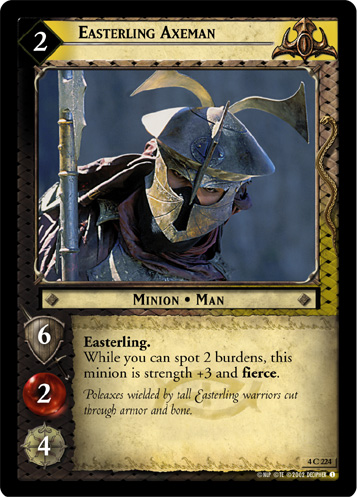 is very efficient when you can spot two burdens, but is unlikely to score any overwhelms like the other two. Ships of Great Draught (8R65)
is very efficient when you can spot two burdens, but is unlikely to score any overwhelms like the other two. Ships of Great Draught (8R65)
 helps set up the combo, Easterling Lieutenant (4C228)
helps set up the combo, Easterling Lieutenant (4C228)
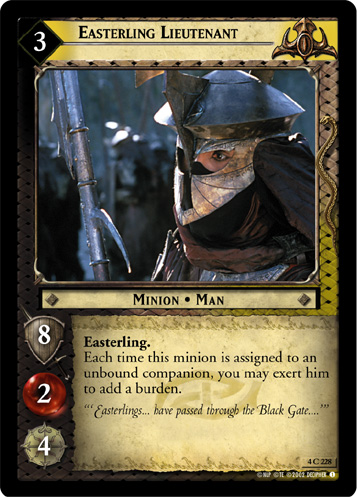 , Vision From Afar (4R259)
, Vision From Afar (4R259)
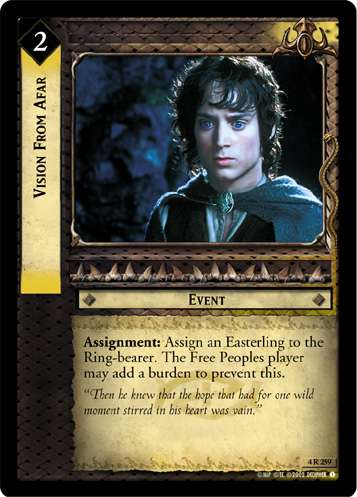 , and New Fear (4R240)
, and New Fear (4R240)
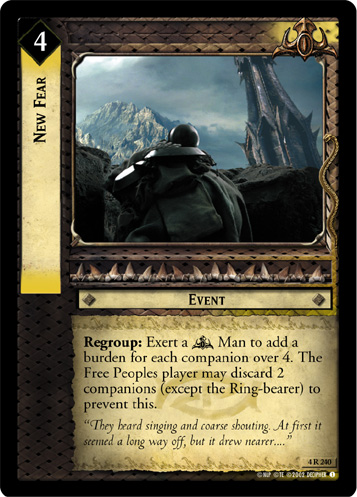 can set even more burdens, and Úlairë Enquëa, Lieutenant of Morgul (1U231)
can set even more burdens, and Úlairë Enquëa, Lieutenant of Morgul (1U231)
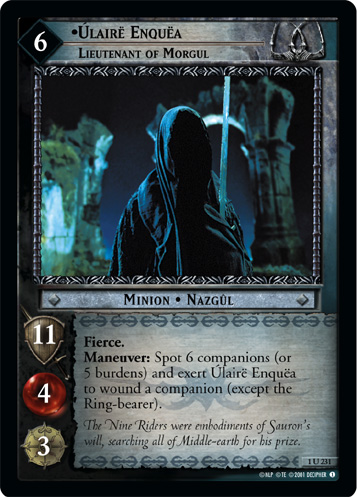 harshly punishes too-large Fellowships or anyone who lets the burden count stack too high.
harshly punishes too-large Fellowships or anyone who lets the burden count stack too high.
Example decks: You Must Be Under 5ft to ride this Fellowship/Easterling Burden Beasts by RJH777 and an untitled Beasterling deck by mathes further down in the same thread. Both decks are Movie Block decks, originally posted on The Last Homely House forums. RJH777's deck goes wider, focusing more on corruption, while mathes's deck focuses more on scoring overwhelms.
Easterlings are also sometimes used as part of a multicultural Corruption deck. Small Hope (7R159)
 , Easterling Lieutenant (4C228)
, Easterling Lieutenant (4C228)
 , Vision From Afar (4R259)
, Vision From Afar (4R259)
 , and New Fear (4R240)
, and New Fear (4R240)
 all have fairly weak cultural enforcement, only requiring that you spot one Easterling. It's possible to add more corruption tools to an Easterling deck, or add an Easterling contingent to a broader corruption deck to quickly set up a few burdens.
all have fairly weak cultural enforcement, only requiring that you spot one Easterling. It's possible to add more corruption tools to an Easterling deck, or add an Easterling contingent to a broader corruption deck to quickly set up a few burdens.
Corsairs[edit]
See also: Corsair
Corsairs were the third and last Raider subculture. Rather than being somewhat worrying racial stereotypes like the other two, they're instead all cameos from the crew of the Lord of the Rings films. If you've felt that Peter Jackson should be as terrifying as the Balrog, then Corsairs have you covered.
Corsairs were introduced with Siege of Gondor, and focus on some of the new King Block mechanics. They stack culture tokens on their ship possessions in the support area. They want to spot those tokens with Corsair War Galley (8U59)
 to seize initiative to activate many of their cards, but they also want to consume those tokens to recur cards from the discard pile. Corsair decks have lots of moving parts, but despite the complexity, it's one of the strongest Shadow sides of Movie Block.
to seize initiative to activate many of their cards, but they also want to consume those tokens to recur cards from the discard pile. Corsair decks have lots of moving parts, but despite the complexity, it's one of the strongest Shadow sides of Movie Block.
There's one main, eponymous Corsair deck, and it's a Movie Block meta staple. It plays Ships of Great Draught (8R65)
 and Corsair War Galley (8U59)
and Corsair War Galley (8U59)
 , often fishing them out of the deck with Corsair Boatswain (10C37)
, often fishing them out of the deck with Corsair Boatswain (10C37)
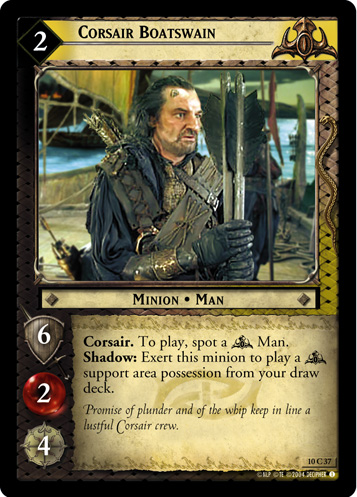 . It then stacks tokens on them with a variety of middling-cost minions like Corsair Plunderer (8C58)
. It then stacks tokens on them with a variety of middling-cost minions like Corsair Plunderer (8C58)
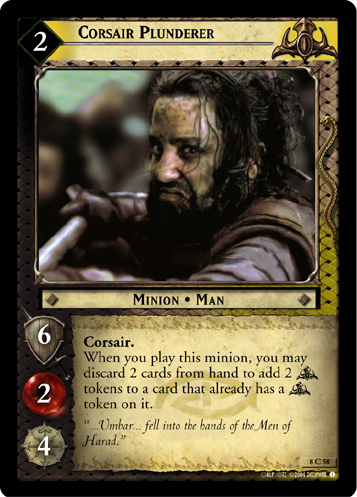 , Corsair Marauder (8R57)
, Corsair Marauder (8R57)
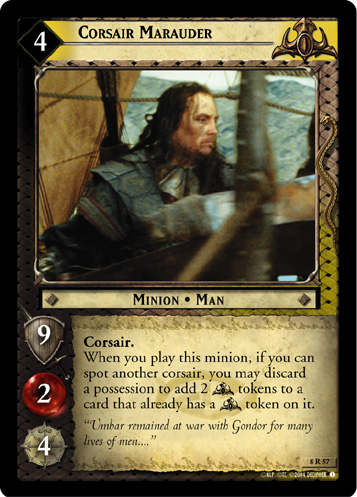 , and sometimes Corsair Lookout (8U56)
, and sometimes Corsair Lookout (8U56)
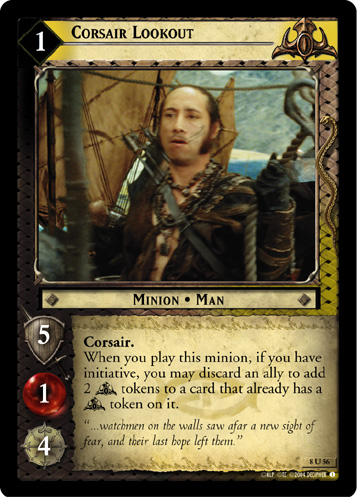 , discarding all of the opponent's possessions and allies in the process, while cycling any unwanted cards out of the hand very easily. Black Sails of Umbar (8C50)
, discarding all of the opponent's possessions and allies in the process, while cycling any unwanted cards out of the hand very easily. Black Sails of Umbar (8C50)
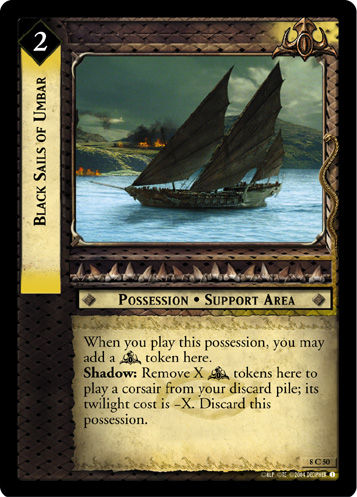 helps make sure none of the tokens go to waste. Many of these cards are fairly situational, but that's fine; any unneeded cards can simply be discarded to Ships of Great Draught (8R65)
helps make sure none of the tokens go to waste. Many of these cards are fairly situational, but that's fine; any unneeded cards can simply be discarded to Ships of Great Draught (8R65)
 instead. Likewise, if anyone starts popping the ships, they can simply be recycled with another copy of Ships of Great Draught (8R65)
instead. Likewise, if anyone starts popping the ships, they can simply be recycled with another copy of Ships of Great Draught (8R65)
 .
.
Once it starts to set up, the Corsair deck has two basic gameplans. The main plan is to play Castamir of Umbar (8R51)
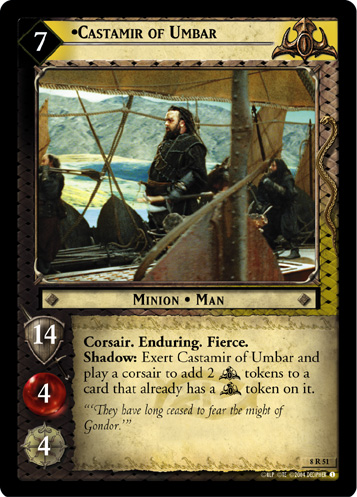 over and over, possibly supported by Raider Halberd (7C156)
over and over, possibly supported by Raider Halberd (7C156)
 to exert him and Wind That Sped Ships (8C66)
to exert him and Wind That Sped Ships (8C66)
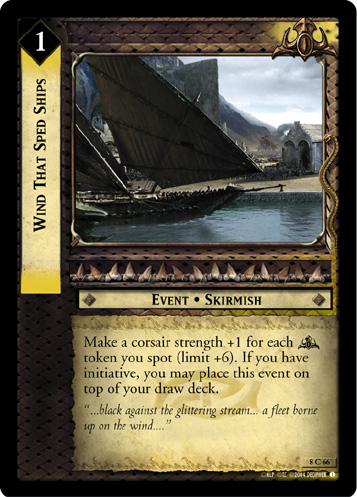 to make absolutely sure he never loses a skirmish. If the opposing Free Peoples deck can comfortably handle a 28 strength fierce skirmisher, then Corsairs can instead go wide, swarming all of their utility minions onto the table with the help of many copies of Black Sails of Umbar (8C50)
to make absolutely sure he never loses a skirmish. If the opposing Free Peoples deck can comfortably handle a 28 strength fierce skirmisher, then Corsairs can instead go wide, swarming all of their utility minions onto the table with the help of many copies of Black Sails of Umbar (8C50)
 and possibly Under Foot (10C52)
and possibly Under Foot (10C52)
 .
.
The dual game plans, combined with the strong cycling and resilience to hate makes Corsairs one of the top Shadow sides of Movie Block, and even keeps it in the running in later formats like Expanded, despite no new cards coming out for Raider culture after Mount Doom.
Example deck: Elven Telepathy - Corsairs, a deck by Murphdaddy on The Last Homely House forums. While this deck is technically for Expanded, the Shadow side is completely legal for Movie Block, and well-suited to that format.
Variants[edit]
It's very easy to graft Corsairs onto any Raider deck. Ships of Great Draught (8R65)
 is just a very powerful card in any
is just a very powerful card in any Raider deck. And while you could run four copies of it, Corsair Boatswain (10C37)
 will download it for you, and maybe absorb some archery while he's there. And since you're running boats now anyway, maybe you could run Corsair War Galley (8U59)
will download it for you, and maybe absorb some archery while he's there. And since you're running boats now anyway, maybe you could run Corsair War Galley (8U59)
 to seize initiative. All of these can help set up your other
to seize initiative. All of these can help set up your other Raider strategy, albeit at the cost of diluting it.
It doesn't even have to be a Raider deck! Moria Navy is a swarm deck that combines the Corsair ships with Under Foot (10C52)
 and the Moria Swarm engine to pump out huge swarms of both Corsairs and
and the Moria Swarm engine to pump out huge swarms of both Corsairs and Moria goblins. It's not quite as reliable as either non-hybrid deck because of cultural enforcement, but when it goes off, it produces many, many more minions than either.
Example deck: Hobbit/ent and Moria's Navy, a Movie Block deck by Not a Zombie on The Last Homely House forums.
Similarly, since you're seizing initiative anyway, you might look at splashable cards in other cultures that benefit from initiative in your own Corsair deck. A common addition is a Gollum splash: Gollum, Plotting Deceiver (7R58)
 can recur himself, and set up cards like Let Her Deal With Them (7R63)
can recur himself, and set up cards like Let Her Deal With Them (7R63)
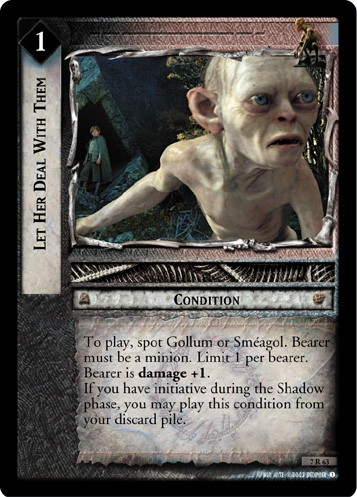 , generate threats with Fat One Wants It (7R57)
, generate threats with Fat One Wants It (7R57)
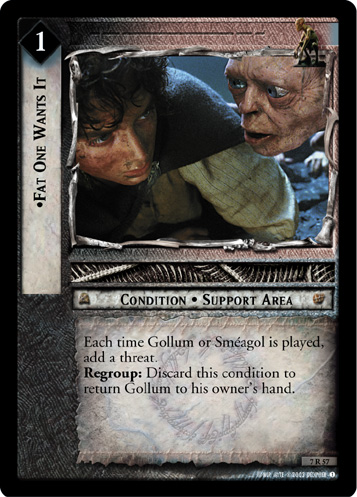 , or simply serve as another body for a swarm.
, or simply serve as another body for a swarm.
| Cultures | |||||||
|---|---|---|---|---|---|---|---|
| Free Peoples | |||||||
| Movie-era Shadow | |||||||
| Shadows-era Shadow | |||||||